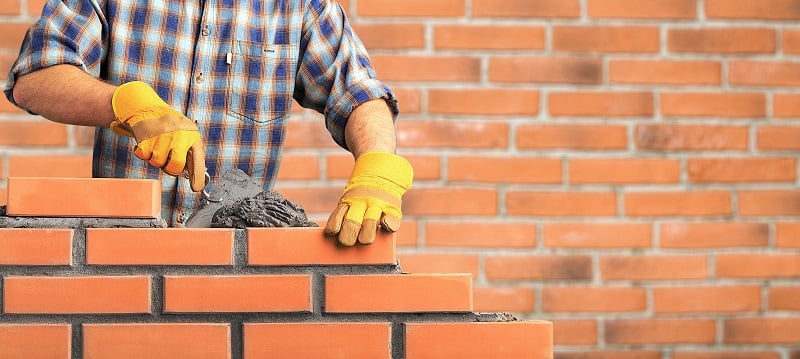Unlocking the Tricks of Lasting Masonry Construction Practices for Eco-Friendly Structures
In the world of contemporary building, the search of lasting practices has ended up being paramount. Amongst the myriad methods to green structure, lasting masonry construction sticks out as a time-tested and resilient method that holds a riches of untapped capacity. From the option of materials to ingenious building techniques, the tricks to accomplishing sustainability within stonework building are complex and intriguing. By exploring the benefits, materials, strategies, and future trends of sustainable stonework, a deeper understanding of just how these techniques can form the future of eco-friendly buildings arises.
Benefits of Sustainable Stonework Building
Embracing lasting stonework building and construction methods not just decreases ecological impact yet also provides lasting financial benefits to home builders and communities. By using products like recycled blocks, blocks, and stones, home builders can significantly reduce the carbon footprint of their projects while promoting resource efficiency. Furthermore, lasting masonry building methods, such as appropriate insulation and thermal mass residential properties, can boost energy performance within structures, resulting in reduced operational costs with time.
Furthermore, the durability and resilience of masonry structures contribute to lasting economic benefits. Structures constructed utilizing lasting stonework methods typically call for less upkeep and fixing, converting to set you back financial savings for building contractors and homeowner. The longevity of stonework products likewise guarantees that structures remain secure and safe and secure, reducing the need for constant renovations or replacements.
Eco-Friendly Stonework Materials
Using green stonework materials is a crucial action towards improving the sustainability of construction practices and decreasing ecological effect while making best use of long-lasting financial advantages. Lasting masonry products are sourced, generated, and used in a manner that lowers overall environmental impact. Products such as recycled bricks, reclaimed rock, and sustainable concrete blocks are ending up being increasingly preferred options for eco-conscious home builders. Recycled bricks, as an example, not only draw away waste from landfills yet also require much less energy to generate compared to new bricks. Recovered rock offers an unique aesthetic allure while decreasing the demand for new quarrying. Lasting concrete obstructs incorporate recycled accumulations and may feature better insulation homes, adding to energy performance in buildings.
Moreover, all-natural products like adobe, rammed planet, and straw bundles give superb thermal mass residential properties, decreasing the requirement for heating and cooling energy. These materials are frequently locally offered, promoting regional economies and decreasing transportation-related carbon discharges. By choosing green stonework products, building jobs can substantially lower their ecological impact and add to the development of healthier, more sustainable built settings.
Energy-Efficient Stonework Methods
Power performance plays an essential duty in boosting the sustainability of stonework building and construction techniques. By applying energy-efficient masonry my site techniques, builders can significantly reduce the total energy consumption of a structure, bring about reduced operational costs and a smaller sized ecological impact. One essential energy-efficient masonry strategy is the usage of thermal mass, which includes integrating thick materials like concrete or block right into the building's structure to soak up and store heat. This assists regulate indoor temperatures, reducing the requirement for mechanical heating and cooling down systems.

Developments in Sustainable Masonry
Recent developments in sustainable masonry methods have produced ingenious methods that are reshaping the construction nearest ford dealership industry. One such advancement is the advancement of self-healing concrete, which utilizes bacteria installed within the concrete to heal fractures autonomously. This advancement not only decreases maintenance prices however also enhances the toughness of masonry structures, contributing to their sustainability.
An additional significant advancement is making use of recycled aggregates in masonry construction - masonry contractor. By incorporating products such as crushed ceramic waste or recycled glass into concrete blends, home builders can minimize the environmental influence of building and construction tasks while preserving architectural stability. This practice not just diverts waste from landfills yet likewise conserves natural deposits, making it a vital innovation in sustainable stonework building
Furthermore, the assimilation of digital layout tools, such as Structure Information Modeling (BIM), is changing the method masonry frameworks are planned and built. BIM allows for even more precise calculations, reduced material wastage, and boosted energy effectiveness, ultimately causing more sustainable building techniques. These advancements collectively symbolize a promising future for lasting stonework building in the period of environmentally friendly structures.
Future Trends in Stonework Sustainability
With the innovative strides made in sustainable stonework practices, the future trends in stonework sustainability are positioned to further transform the building industry. One of the essential patterns forming the future of masonry sustainability is the boosted combination of innovation. Innovations such as Structure Details Modeling (BIM) and virtual truth simulations are being used to maximize stonework building and construction procedures, leading to reduced product waste and improved power efficiency in buildings.
Additionally, the growth of unique sustainable materials is set to play a significant function in improving the eco-friendliness of masonry building and construction. masonry contractor. Advancements like self-healing concrete, recycled aggregates, and bio-based binders are obtaining traction for their capacity to decrease environmental effect while preserving structural integrity

Final Thought
To conclude, sustainable stonework construction methods use numerous advantages for environmentally friendly structures. By utilizing eco-friendly products and energy-efficient methods, masonry can add to an extra lasting built atmosphere. Advancements in lasting masonry are constantly being established to even more improve the environmental efficiency of structures. Looking towards the future, the fad of masonry sustainability is expected to expand, resulting in more eco-friendly and energy-efficient construction practices in the years to find.